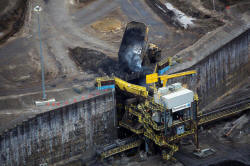|
Canadian heavy oil plugs
gap left by OPEC, Latam
 Send a link to a friend
Send a link to a friend
 [July 31, 2017] By
Nia Williams [July 31, 2017] By
Nia Williams
CALGARY, Alberta (Reuters) - Canada's
struggling oil market has found something of a lifeline as traders
scramble for heavy crude due to OPEC production cuts and sinking Latin
American output.
Output has fallen in Organization of the Petroleum Exporting Countries
and non-OPEC Latin American countries such as Mexico and Colombia,
leading refiners as far away as China to look to Alberta's oil sands to
fill the gap.
The interest has boosted the price for heavy Western Canada Select (WCS)
oil, which is within range of its tightest discount to U.S. crude ever.
Canadian heavy oil is an easy substitute for Middle Eastern and Latin
American grades, and the rising demand represents a rare bright spot for
the oil sands, which have been hit hard by falling prices and the high
cost to produce and blend Alberta's heavy, tar-like bitumen.
"We've been seeing a structural change (in the market) since OPEC cut
medium sours, and Canadian heavy fits beautifully in there," one trader
at an oil sands company said.
OPEC is attempting to rebalance global markets by cutting sour crude
output, keeping light sweet barrels flowing as U.S. shale producers are
pumping at record levels.

Output in Venezuela, an OPEC member, fell 11 percent in the first five
months of the year to a 27-year-low due to underinvestment and
infrastructure problems. And as political turmoil mounts there, the
United States could impose sanctions that would hinder Venezuela's
ability to sell crude.
Mexico's production fell 8 percent in the first five months of 2017 from
a year ago as a result of long-running natural production declines in
aging oilfields. Colombia's dropped 11.5 percent as a consequence of
rebel attacks on pipelines.
Venezuela, Mexico and Colombia produce about 5.3 million barrels per
day, while OPEC has cut about 1.8 million bpd in supply, most sour
crude.
Gulf Coast refiners are paying more for Canadian production to replace
these barrels, pushing the discount for Canadian oil delivered to the
U.S. storage hub in Cushing, Oklahoma, to around $5 a barrel below U.S.
crude. At current levels that would put the outright price of WCS at
Cushing at just under $45 a barrel.
The narrowest differential at Cushing was $4.10 per barrel below U.S.
crude in mid-2015.
[to top of second column] |

Giant dump trucks dump raw tar sands for processing at the Suncor
tar sands mining operations near Fort McMurray, Alberta, Canada on
September 17, 2014. REUTERS/Todd Korol/File Photo

Canada exports more than 3 million barrels of crude daily to the United States,
its No. 1 customer, according to U.S. Energy Department data. Canadian barrels
could supply refineries in Sweeney, Texas, and St. Charles, Louisiana, where
Venezuela accounts for the majority of imports.
Major beneficiaries would be producers with committed capacity on Enbridge Inc
pipelines that funnel crude to the Gulf, like Suncor Energy and MEG Energy,
because they enjoy lower tariffs than spot shippers.
Sending more Canadian oil to the United States may be difficult due to pipeline
constraints, though more oil could be sent by rail, albeit at a higher price.
High costs and poor returns prompted international energy companies to sell
around $22.5 billion in Canadian assets this year.
With OPEC cuts now starting to bite in Asia, traders said demand for sour
barrels was rising in a region that historically sourced oil from the Middle
East and Russia.
Two traders in Calgary said their companies were getting more calls from
potential Chinese buyers, and declining freight rates meant more Canadian crude
could make its way to Asia.
State-owned Indian Oil Corp bought its first cargo of U.S. and Canadian heavy
crude in July, and 1 million barrels of Canadian crude went to China in the
first quarter.
"So many tankers out there are looking for work it would not be surprising for
somebody to get a sweetheart deal to take it to Asia," said RBC analyst Michael
Tran. However, the country's lack of pipelines to the coast make significant
exports to Asia unlikely, he said.
(Reporting by Nia Williams; Additional reporting by Florence Tan in Singapore
and Marianna Parraga in Houston; Editing by Toni Reinhold)
[© 2017 Thomson Reuters. All rights
reserved.] Copyright 2017 Reuters. All rights reserved. This material may not be published,
broadcast, rewritten or redistributed.
 |